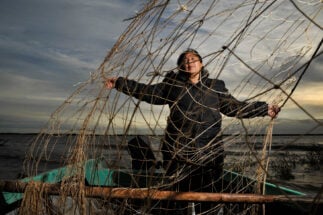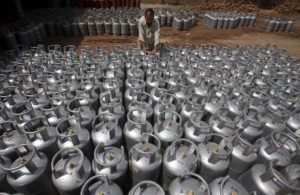The year 2015 was a warning for Titicaca, the lake that straddles the border between Peru and Bolivia at 3,800 metres above sea level. Over the course of the year, thousands of giant Titicaca water frogs (Telmatobius culeus), fish and birds washed up dead on the Bolivian side of the lake, South America’s second largest.
“It was a wake-up call of what could also happen to us,” recalls Vilma Paye, 48, a women who lives in Sampaya, an Aymara indigenous community on Titicaca’s Bolivian shores.
That same year, Lake Poopó, which is connected to Lake Titicaca by the Desaguadero River, dried up completely. Disaster followed months later, when another 10,000 giant frogs died on the Coata River, a tributary which flows into the Peruvian part of the lake.

It was a crisis foretold. “Our grandparents said the climate was going to change and also that some species would become extinct, but we never believed it,” says Paye, one of 50 indigenous leaders in the Mujeres Unidas en Defensa del Agua (Women United in Defence of Water), a network created in 2016 to save Titicaca from pollution.
“It is alarming that we ourselves are polluting it, because this is going to cause us to become extinct – just like the giant frogs,” she adds.
A symptom of the crisis
What is happening to this endangered aquatic amphibian is a symptom of the degradation of the world’s highest navigable lake. Wastewater discharges and waste from homes, hospitals and mining operations are polluting Titicaca and its entire basin, from the Desaguadero River to Lake Poopó.

Several studies have already confirmed the presence of heavy metals in its waters, such as arsenic, cadmium, mercury and lead, among others.
“We can feel what this is causing, because we [women] are the heads of the household and we use water for everything,” says Paye.
Paye joined Mujeres Unidas in 2020. Together with Aymara and Quechua women defenders, she collects plastic bottles and bags from Titicaca’s shores, raises awareness among young people in schools, talks to the authorities and even measures the quality of the water in order to heal her ancestral lake.
A refuge in captivity
After the mass die-offs of frogs in 2015, an emergency team rescued the survivors in Wiñaymarka, the southern portion of Lake Titicaca, to keep them at the K’ayra Centre, the only facility in Bolivia dedicated to protecting threatened amphibian species.
“Because they have such permeable skin, frogs are sentinels of our environment,” says biologist Teresa Camacho Badani, who is in charge of the research and conservation centre in Cochabamba, some 430 kilometres from the Wiñaymarka Lake.

“Nobody realises that what is happening to these frogs, to some extent, can happen to us. We must take notice of this signal that nature is giving us before it is too late,” the herpetologist adds.
During their rescue, the Titicaca frogs went through something of an odyssey once they left the lake. The team evacuated 35 amphibians from the polluted waters by plane, with support from the International Union for Conservation of Nature (IUCN) and Amphibian Ark, among other organisations. They then undertook an overland journey to the K’ayra Centre and finally settled in a conditioned container where no pollutants enter and a control system simulates the temperature and daylight hours of their natural habitat.
This refuge is part of the Alcide d’Orbigny Natural History Museum in Cochabamba, which was declared a National Heritage Site in 2014. To date, it houses 450 individuals belonging to five species of the genus Telmatobius – native to the Andes – such as the giant Titicaca frog, as well as two terrestrial species, including the glass frog (Nymphargus bejaranoi), which had not been seen in 17 years.

In this environment, the rescued Titicaca frogs reproduced in mid-2020, bringing their population to more than 290 individuals. For Camacho, this is the result of a great efforts to help these amphibians overcome the stress they have undergone due to the deterioration of their habitat.
Guardians of the species
In the community of Perka Norte, located on Peru’s Titicaca coast, there is still hope for the giant frogs. In 2017, a scientific mission from Denver Zoo in the US, the Cayetano Heredia University in Lima and Peruvian non-profit organisation Natural Way surveyed 13 spots in the lake. In most, there were no frogs. At some sites, only one to four frogs were found in 100-metre transects; at Perka Norte, however, the number was as high as 20 frogs.

“We weren’t aware that frogs were disappearing in other communities,” says Elvira Chicani, a 45-year-old leader and artisan who used to fish with her grandparents in this Aymara village. “Sometimes they got caught in our nets, but we have always thrown them back into the lake so that they can grow bigger. Now we are looking after them much more because people want to take them to the markets.”
In addition to pollution, the biggest threat facing this Titicaca amphibian is its trafficking for its use and sale as the main ingredient in green “frog juices” in cities, such as Lima, due to popular beliefs about its supposed healing properties. In fact, it is the most trafficked species in Peru, according to an investigation by InSight Crime, accounting for more than 50% of the 20,000 animals seized by authorities between 2015 and 2020.
For this reason, after the findings of 2017, Natural Way continued with a population density study of the Titicaca frog, in collaboration with the Perka Norte community.

According to Jhazel Quispe, a biologist in charge of the organisation, during those months of research it was discovered that the traffickers had not yet arrived in this community, located an hour by boat from the city of Puno. It was also confirmed that its inhabitants had no connection with the frog other than its infrequent involvement in a ritual to call for rain. Moreover, the animal was considered unpleasant looking, with children said to be afraid of it.
“We came to understand that if at some point they were offered money to extract frogs, they were going to do it because they didn’t feel much affection for them,” says the researcher.
In this respect, community leader Chicani is firm: “We don’t allow that here. Environmental education with the community – and especially with children and young people – was a central strategy to conserve this aquatic amphibian.”
Chicani reports that traffickers have arrived in cars asking where they could find frogs. “Sometimes we see boats coming, we take pictures of them and pass the word to the authorities,” she says. “But we have chased them away.”
Other endangered species
The ecological disaster at Lake Titicaca is wiping out other native species, such as the Titicaca grebe (Rollandia microptera). In 2019, 119 of these flightless waterbirds were found dead in Suchipujo, on the Peruvian side. “The species that are dying are endemic and, therefore, indicators of any change in the quality of the lake,” says biologist Quispe.

For Bolivian community leader Elizabeth Zenteno, the lake is approaching a point of no return. “Titicaca has lost its capacity for self-recovery, because the pollution is such that the lake is not resilient – it is now a polluted body,” says the environmental engineer, who has been involved with the Mujeres Unidas for a little over a year.
In the last three decades, Titicaca, with a total area of over 8,200 square kilometres, has lost 90% of native fish species mainly due to overfishing and pollution, according to a recent diagnosis by the Binational Autonomous Authority of Lake Titicaca. An estimated 20 species of Orestias, a genus of fish, have become extinct over the past six decades, while another six are on the brink of extinction.
A future in the lake
For the frogs at the K’ayra Centre to return to Titicaca, the ecosystem conditions must be made safe again. To release them now “would be to condemn them to die”, laments the herpetologist Camacho.

Since 2019, the conservation centre has launched a scientific mission – once more with Natural Way, Cayetano Heredia University and Denver Zoo, alongside the Pontifical Catholic University of Ecuador – to study the habitat of the Titicaca giant frog, its threats and the genetics of this species. This research, supported by the United Nations Development Programme, aims to improve its care so that this amphibian can have a long-term future.
In this vein, its defenders are seeking to have Lake Titicaca declared a subject with legal rights in Peru. This recognition was granted last year in Bolivia, due to the risk of “the disappearance of all forms of animal and plant life that live in its bed and banks”.
This article was published as part of Comunidad Planeta, a project led by Periodistas por el Planeta (PxP) in Latin America, of which Diálogo Chino is a partner.









